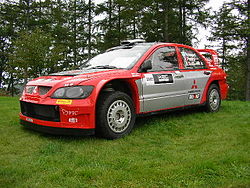Blog Archive
 | |
| Manufacturer | Mitsubishi Motors Ralliart |
|---|---|
| Parent company | Mitsubishi Motors |
| Production | 2001–05 |
| Successor | Mitsubishi Racing Lancer |
| Class | World Rally Car |
| Body style(s) | 4-door sedan |
| Engine(s) | 4G63 2.0 L DOHC 16v I4, turbocharger |
| Transmission(s) | sequential transmission; front, centre & rear LSDs; four-wheel drive |
| Wheelbase | 2,600 mm (102.4 in) |
| Length | 4,360 mm (171.7 in) |
| Width | 1,770 mm (69.7 in) (2001–04) 1,800 mm (70.9 in) (2005) |
| Curb weight | 1,230 kg (2,712 lb) |
| Fuel capacity | 90 L (19.8 imp gal; 23.8 US gal) |
WRC
The Lancer Evolution WRC is powered by the same 1996 cc 4G63 engine that has been used in its sports and rally cars since the 1980s, in this iteration producing 300 PS (221 kW) at 5500 rpm and 540 N·m (398 lb·ft) at 3500 rpm.WRC2
The Lancer Evolution WRC2 is also powered by the 4G63, also producing 300 PS (221 kW) at 5500 rpm and 540 N·m (398 lb·ft) at 3500 rpm. It is mated to a 6-speed INVECS-type sequential transmission via a triple-plate carbon clutch and distributes power to all four wheels via front-, centre- and rear- active differentials. The car's suspension is independent, with MacPherson struts and coil springs at each corner. The brakes are vented discs clamped by 6-piston calipers at the front, and 4-piston calipers at the rear.WRC04
The Lancer WRC04 continued with the 4G63 engine, mounted to a 5-speed semi-automatic transmission and a new all-wheel drive system co-developed by Ricardo Consulting Engineers and Mitsubishi Motors Motorsports (MMSP). The bodywork was subjected to extensive aerodynamic testing at the Lola Cars wind tunnel. The front brakes were upgraded to 8-piston calipers clamping 370 mm (15 in) discs.The lead Lancer WRC04 in the 2004 World Rally Championship was driven by ex-Peugeot driver Gilles Panizzi, with his brother Hervé as co-driver.
WRC05
The Lancer WRC05 saw no significant changes to the powertrain, but the car's width was increased by 30 mm (1.2 in) due to a change in the WRC regulations. Aerodynamic alterations to the bodywork were introduced to improve stability, while suspension links and driveshafts were lengthened. Steering-mounted gearshift paddles were also introduced, and longer ratios were adopted for first, third and fourth gears.
Label
- Alkitab (5)
- anime (14)
- Arti nama (3)
- Automotif (138)
- Award (1)
- Bahaya (1)
- Bangunan Unik (8)
- belajar html (1)
- benda (24)
- Binatang (36)
- Biografi (81)
- Biologi (6)
- buah (12)
- cara belajar (2)
- CIA (1)
- Community (2)
- contact (1)
- Daerah (18)
- Dewa (2)
- Dijual (1)
- Download software (5)
- drift (1)
- Ekonomi (1)
- FBI (1)
- film (33)
- Fisika (11)
- Game (37)
- ganti kusor blog (1)
- Geografi (27)
- hacker (7)
- Hewan Punah (5)
- Ilmu (48)
- ilmu Beladiri (4)
- Istilah (5)
- kata kata bijak (2)
- kata2 bijak (1)
- Kecepatan (14)
- kimia (1)
- kisah nyata (6)
- Komputer (7)
- Kristen (4)
- kuno (6)
- LAPD (1)
- link (2)
- lirik lagu (3)
- membuat virus (1)
- membuat virus melalui notepad (1)
- membuat virus via notepad (1)
- Misteri (67)
- Misteri dunia (51)
- Mitos (10)
- NASA (88)
- negara (5)
- Organisasi (2)
- Parkour (1)
- Pelajaran (1)
- Perjalanan (1)
- Perkembangan (2)
- petshop (9)
- petugas (1)
- PKN (3)
- pohon (5)
- Puisi (1)
- pulau (9)
- Rahasia (1)
- rubic (2)
- Saion (1)
- sastra (3)
- sejarah (29)
- Senjata (73)
- situs populer (7)
- Sniper (1)
- tata surya (27)
- Teknik (15)
- telepati (1)
- Tenga dalam (1)
- the power of kepepet (1)
- The Three Kingdom (8)
- TIps Binatang (10)
- Tips blogger (4)
- tradisi (9)
- tragedi (4)
- trick magic (2)
- Tumbuhan (1)
- UFO (1)
- Yesus (2)
Loading
Tian's Fan Box
Tian on Facebook
Copyright 2010 Tian
Theme designed by Lorelei Web Design
Blogger Templates by Blogger Template Place | supported by One-4-All





0 komentar:
Posting Komentar